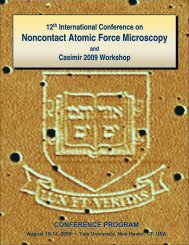Circuit Quantum Electrodynamics - Yale School of Engineering ...
Circuit Quantum Electrodynamics - Yale School of Engineering ...
Circuit Quantum Electrodynamics - Yale School of Engineering ...
Create successful ePaper yourself
Turn your PDF publications into a flip-book with our unique Google optimized e-Paper software.
CHAPTER 2. CAVITY QUANTUM ELECTRODYNAMICS 37<br />
universe forward! A canonical example <strong>of</strong> an irreversible process, cooling <strong>of</strong> trapped atoms relies on<br />
spontaneous decay to break the symmetry between heating and cooling. Long decay times associated<br />
with atomic microwave transitions, while good for coherence, make it difficult to cool and trap such<br />
atoms based on their microwave transitions. Because excitations are equally shared between atoms<br />
and the cavity, they decay at the average <strong>of</strong> the two rates, Γeff = (γ⊥ + κ)/2. When κ ≫ γ the<br />
cavity speeds up the atom decay, allowing faster extraction <strong>of</strong> energy. Future experiments might<br />
couple circuit based cavities to increase the cooling efficiency <strong>of</strong> atom trapping/cooling. In fact, this<br />
particular trick known as the Purcell effect [Purcell1946] works even if g < κ, where the effective<br />
decay rate becomes Γeff = g 2 /κ. In addition, the Purcell effect allows one to redirect decay from<br />
lossy internal modes (γ⊥) to controlled radiative modes (κ), a property sometimes used to enhance<br />
the emission <strong>of</strong> LED’s [Boroditsky1999].<br />
Exercise 2.0.1. Using degenerate perturbation theory find the eigenstates and energies for the res-<br />
onant (ωa = ωr) Jaynes-Cummings Hamiltonian in Eq. 2.1.<br />
Exercise 2.0.2. Derive the Purcell effect, by calculating the overlap <strong>of</strong> the cavity and qubit wave-<br />
functions. Does the decay depend on the photon number? Why or why not?<br />
2.1 Dispersive Limit<br />
In the resonant limit (ωa −ωr ≪ g), the atom and photon can exchange energy causing them to lose<br />
their individual character, and forming a strongly coupled system. In many cases it is preferable for<br />
the interaction to be dispersive, where no actual photons are absorbed by the atom. This can be<br />
achieved by detuning the atom and cavity by ∆ = ωa − ωr where g ≪ ∆. In this dispersive limit,<br />
the effect <strong>of</strong> the dipole interaction can be modeled using (non-degenerate) perturbation theory (see<br />
Ex. 2.1.1)). Expanding in powers <strong>of</strong> g/∆ to second order yields the approximate Hamiltonian:<br />
�<br />
H ≈ � ωr + g2<br />
∆ σz<br />
�<br />
�a � †<br />
a + 1/2 + �ωa σz/2 (2.2)<br />
The atom and cavity still interact through the dispersive shift term proportional to g 2 /∆. Because<br />
it commutes with the rest <strong>of</strong> the Hamiltonian it conserves both the photon number and the atom<br />
state, but shifts the energies <strong>of</strong> both the atom and the photons (see Fig. 2.2b). The first term<br />
remains the Hamiltonian <strong>of</strong> a harmonic oscillator, but the effective frequency ω ′ r = ωr ± g 2 /∆,<br />
depends on the state <strong>of</strong> atom (see Fig 2.2b). This atom state dependent cavity shift can be used to















